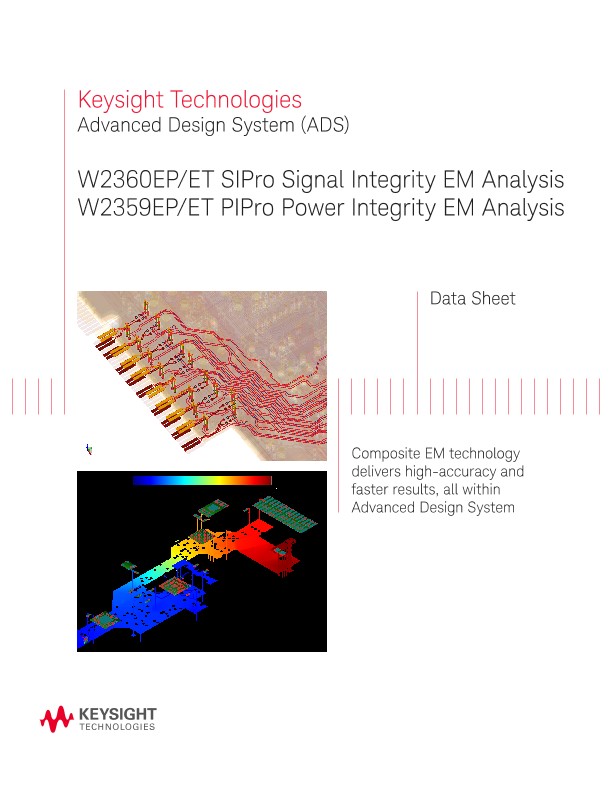
W2360EP/ET SIPro, W2359EP/ET PIPro
Data Sheets
Keysight Technologies
Advanced Design System (ADS)
W2360EP/ET SIPro Signal Integrity EM Analysis
W2359EP/ET PIPro Power Integrity EM Analysis
New Cohesive Workflow Redefines SI/PI Solutions
Signal Integrity (SI) and Power Integrity (PI) are often treated as separate design tasks that are closely interrelated, with the same end-goal for a design: Ensure high-speed link performance and system-level reliability.
Consider now a single user interface for both PI and SI analyses, where one setup can be easily copied from one analysis-type to another, with simulations run in the same environment. In ADS, SIPro and PIPro deliver this ideal, sharing a common GUI, workflow, model database, and results visualization; eliminating the need to switch between different point tools, and allowing better collaboration between engineers. Furthermore, with the high-capacity EM solvers in SIPro and PIPro, it is no longer necessary to spend hours manually simplifying designs, reducing size by cookie-cutting and removing layers and nets, that is typically required with general purpose EM tools.
SIPro
A Fraction of the Full Wave 3DEM Simulation Time
SIPro provides signal integrity analysis of your high-speed PCBs. It empowers you to characterize loss and coupling of signal nets, signal and power nets, and complete ground nets at once. The resulting EM model can be transferred to the ADS Transient and Channel Simulators in one seamless flow.
Speed and accuracy
- Innovative composite EM technology for fast and accurate simulations of large, complex PCB designs
- Based on pure EM technology that delivers accuracy approaching industry-standard 3D EM solvers, in a fraction of the time
- Focused net-driven use-model specifically for SI/PI, to be much faster and more efficient than general purpose EM tools
- EM effects captured:
- All relevant signal coupling
- Accurately modeled ground return paths, cut-outs and drills in GND/PWR planes
- Via-via coupling
- Via transition effects
- Via-GND/PWR coupling
Layout to results in less than 20 clicks
- No layout simplification required!
- Net-driven setup
- Guided port creation
- Quickly plot all crosstalk elements from the same component
Innovations in EM - Mesh Domain Optimization
- SIPro optimally reduces the problem size to solve of the final mesh. Removing areas of the mesh that will have no bearing on the simulation results.
SIPro
The following analyses can be performed in SIPro:
EM model extraction
- Generate an EM-accurate model that captures signal-net losses and coupling
- Filter by port, by net, by impedance, for quickly finding and plotting the desired relationships
- Frequency domain S-parameter results
- Time domain TDR and TDT results
- Mixed-mode S-parameters (e.g. Differential to Common mode conversion)
- Fast plotting of crosstalk (NEXT, FEXT)
- Fast change of reference impedances for plotting without resimulation
Complete channel analysis
- With Automatic Schematic Generation, the extracted EM model flows directly into an ADS transient simulation and ADS channel simulation
PIPro
Accurate and Efficient Net-Driven PI Analysis
PIPro provides power integrity analysis of your power distribution network (PDN), including DC IR drop analysis, DC IR Drop Electro-Thermal analysis, AC impedance analysis and power plane resonance analysis.
Speed and accuracy
- Pure EM-based solution
- DC IR drop analysis
- AC PDN impedance analysis
- Power plane resonance analysis
- DC IR Drop Electro-Thermal analysis
- Thermal Analysis
- Bill of materials optimization utility for best decap and inductor selections
Designed for usability
- Full-time 3D view of layout, selected nets, ports and components
- Filter by Net
- Filter by Component
- Right-click to add-to-analysis
- Drag & Drop
- Hierarchical search for complex selections
- Context sensitive menus e.g. ‘Select instances connected only to all selected nets’
- Quickly compare two sets of results with the “Compare-To” feature
DC IR drop analysis
- Voltage delivered to each sink, and failures based on user-defined tolerances
- Current flow through each via, with over-current failures reported. Current limits are set proportionally to the area of the via, an equation that is editable by the user
- 3D power dissipation visualization
- 3D voltage distribution visualization
- 3D current density visualization
Power plane resonance analysis
- Analyze self-resonancesof the PCB and inspect trouble areas that have the highest field strength
- Report self-resonant frequencies and quality factors for the PDN
- 3D field plots
Results reporting
- Power Tree Representation
- Comprehensive output reports (html and docx formats)
DC IR Drop Electro-Thermal
As power delivery networks are forced into tighter PCB real-estate, the power plane becomes far from idealized. The power and ground planes become heavily perforated with clearance holes from signal vias and stitching vias. It can be a struggle for the layout engineer to get the required current up into the package of the device that requires it, without passing through narrow traces of metal. Calculating an accurate IR-Drop is important for the PI designer, but also knowing the absolute temperature that the PDN traces, vias and chip die will reach, is invaluable information. High temperatures can cause reliability issues; as the temperature cycles from on/off states can cause the via barrels to weaken and crack over time.
It is not intuitive to the designer whether a via is undersized for the current that is passing through it. The temperature rise is very dependent on the width of the traces attached to it. Secondly, resistance of a trace increases with temperature, requiring simulation analyses to determine the final steady state condition. For every 10 degC change in temperature we see a 4% change in resistance of a trace.
These observations point to a need to simulate the PDN design with a DC IR Drop Electro-Thermal solution.